
Melaleuca viminalis, commonly known as weeping bottlebrush, or creek bottlebrush is a plant in the myrtle family, Myrtaceae and is endemic to New South Wales, Queensland and Western Australia. It is a multi-trunked, large shrub or tree with hard bark, often pendulous foliage and large numbers of bright red bottlebrush flowers in spring and summer. It is possibly the most commonly cultivated melaleuca in gardens and its cultivars are often grown in many countries.
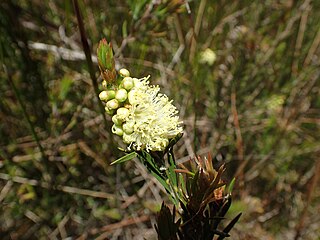
Melaleuca paludicola, commonly known as river bottlebrush, is a plant in the myrtle family, Myrtaceae and is endemic to eastern Australia. It is a shrub or small tree with flexible, often drooping branches, pinkish new growth and spikes of cream, pale yellow, or sometimes pink flowers in summer.

Melaleuca subulata is a plant in the myrtle family Myrtaceae, and is endemic to south eastern Australia.. It is a small, spreading shrub with hard bark, dense foliage, cylindrical leaves and spikes of dark crimson flowers in summer.

Melaleuca recurva, commonly known as Tinaroo bottlebrush, is a plant in the myrtle family, Myrtaceae and is endemic to higher areas of far northern Queensland in Australia.. It is a shrub with spikes of red flowers tipped with yellow in most months of the year and which often has leaves with their edges curled under.

Melaleuca squamophloia is a plant in the myrtle family, Myrtaceae and is endemic to the black soil plains of south eastern Queensland in Australia. Like its close relative Melaleuca styphelioides, it is a small, erect tree with prickly leaves and spikes of cream or white flowers but its bark is hard rather than papery and the leaves have fewer veins than that species.
Melaleuca stipitata is a plant in the myrtle family, Myrtaceae and is endemic to a small area in the Northern Territory of Australia. It is a rare species, only discovered in 1991 and is unusual in that it is the only known example of Melaleuca having stalked flowers. Its leaves have an essential oil with a pleasant, lemon scent possibly suitable for commercial production.
Melaleuca citrolens, commonly known as gulbarn, is a plant in the myrtle family, Myrtaceae and is endemic to northern Queensland and the north-eastern part of the Northern Territory. Plants in this species were originally included in Melaleuca acacioides until a review of the genus in 1986.
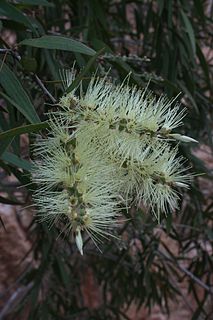
Melaleuca fluviatilis is a plant in the myrtle family, Myrtaceae and is endemic to northern Queensland in Australia. It is a tree with papery bark, narrow leaves and spikes of white or creamy-coloured flowers, usually growing along streams and rivers. It is common in tropical areas and is sometimes confused with Melaleuca argentea although it lacks that species' silvery foliage.

Melaleuca stenostachya, commonly known as fibre-barked teatree or straight teatree is a plant in the myrtle family Myrtaceae and is native to the Cape York Peninsula in northern Australia, the gulf country of the Northern Territory and the south of Papua New Guinea. It is closely related to Melaleuca dealbata but can be distinguished from that species by the wide separation of the flowers in the inflorescence.

Melaleuca pyramidalis is a plant in the myrtle family, Myrtaceae and is endemic to small areas of Queensland in Australia. It is closely related to Melaleuca citrina but is distinguished from it mainly by leaf and stamen differences. Melaleuca pyramidalis is only known from the summits of three mountains in Queensland.
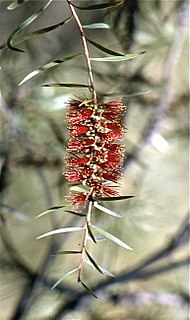
Melaleuca chisholmii commonly known as Burra bottlebrush is a plant in the myrtle family, Myrtaceae and is endemic to Queensland. It is a shrub with rough bark, an open habit and spiky foliage but in winter has bright red flower spikes tipped with yellow.

Melaleuca flammea, commonly known as tapering-leaved bottlebrush, is a plant in the myrtle family, Myrtaceae and is endemic to New South Wales and Queensland in Australia. It is a shrub with broad, lance-shaped leaves which have wavy edges and taper gradually to a fine point. In spring it has typical bottlebrush flowers whose fiery colour gives the species its name.
Melaleuca hemisticta, commonly known as Mount Wheeler bottlebrush is a plant in the myrtle family, Myrtaceae and is endemic to coastal areas of Queensland. It is a tall, bushy shrub with dark green leaves and red flowers spikes tipped with yellow.
Melaleuca lazaridis is a plant in the myrtle family, Myrtaceae and is endemic to the Blackdown Tableland National Park in Queensland.. It is a shrub with dark green leaves and red flowers spikes tipped with yellow.
Melaleuca montis-zamia is a plant in the myrtle family, Myrtaceae and is endemic to the Springsure district in Queensland, Australia. It is a shrub with red bottlebrush flowers.
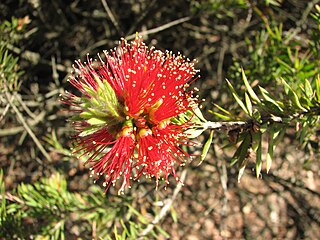
Melaleuca pearsonii, commonly known as Blackdown bottlebrush, is a plant in the myrtle family, Myrtaceae and is endemic to Queensland in Australia. It is a small, spreading but compact shrub with hard bark, soft foliage and profuse spikes of bottlebrush flowers in spring and summer.
Melaleuca phratra is a plant in the myrtle family, Myrtaceae and is endemic to Queensland in Australia. It is a large shrub similar to Melaleuca paludicola but has flower spikes that are a shade of pink.

Melaleuca polandii, commonly known as gold-tipped bottlebrush, is a plant in the myrtle family, Myrtaceae and is endemic a small area in far northern Queensland in Australia. It is a dense shrub with bronze-coloured, hairy new growth and spikes of red flowers tipped with yellow.
Melaleuca quercina, commonly known as Oakey bottlebrush is a plant in the myrtle family, Myrtaceae and is endemic to a small area of Queensland in Australia. It is small tree with dark, corky bark and spikes of yellow, cream or pink bottlebrush flowers in spring and summer.
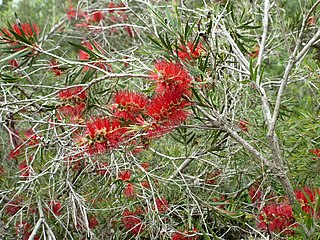
Melaleuca sabrina is a plant in the myrtle family, Myrtaceae and is endemic to a small area near the border between New South Wales and Queensland in Australia. It is a shrub with fibrous bark and red or pink bottlebrush flowers, tipped with yellow in spring and summer. It is similar to Melaleuca paludicola but distinguished from it by its stamens, which are almost twice as long as those of M. paludicola.












